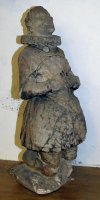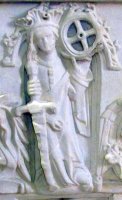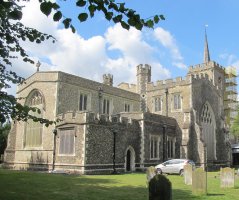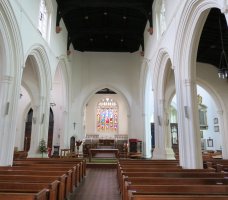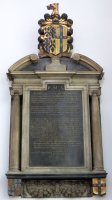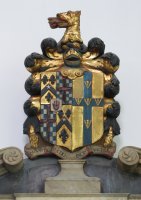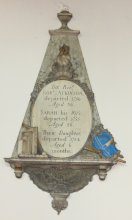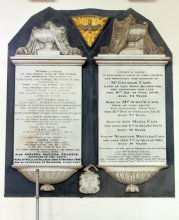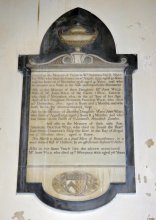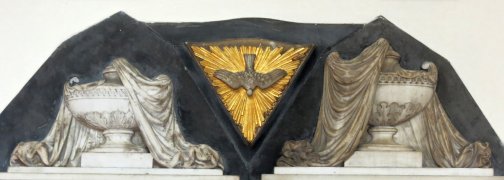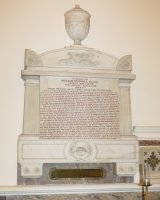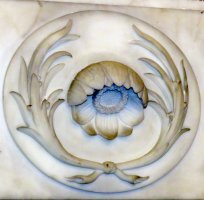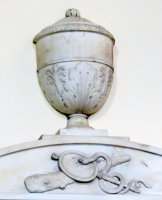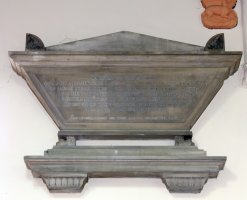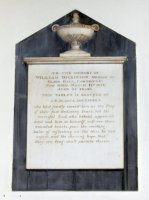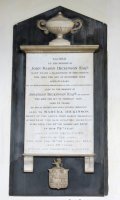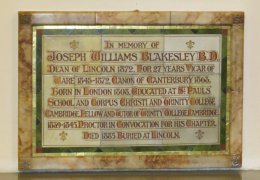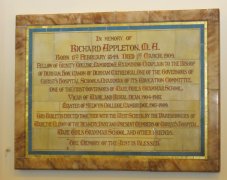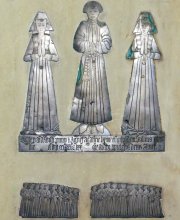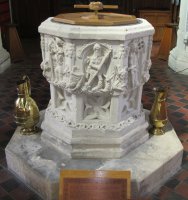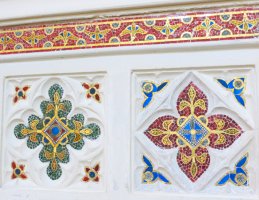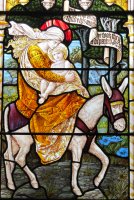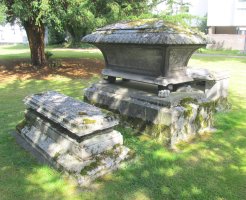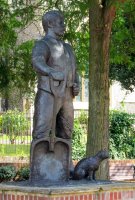Ware Church, St Mary, in Hertfordshire - Monuments
Ware Parish Church is a 13/14th Century town church, much renewed, which is notable for its brasses, a large 17th Century panel monument, and has a score of later panels, mostly quite simple but a few more interesting, including one by sculptor Peter Rouw. There is a single damaged kneeler statue, and aside from the monuments, the font is particularly notable, and some of the stained glass.
St Mary's Church, Ware.
St Mary the Virgin Church, Ware is quite large, all of flint with stone dressings round the windows, heavily battlemented, with little turrets, and the low square West Tower bearing a small spire of the type called a Hertfordshire Spike. Some of the windows are Decorated, those on the tower are Perpendicular, and the dates of the building are from the 13th and 14th Century, with a considerable restoration in Victorian times. Inside all is light, roomy and open, with the monuments clustered at one end – alas, many of these were removed and lost in the 19th Century works, and what we have today are a single battered kneeler, one big 17th Century wall panel, a few 18th Century pieces, and a number of early 19th Century mostly white-on-black panels together with a few more modern panels.
We take the monuments in date order:
Monuments:
Akneeler figure. We see the battered sculpture of a kneeling man, his face upturned, his head bare, wearing a wide ruff above a tunic of some sort covered by a mantle. His arms are in an attitude of prayer, but the hands are gone. Below, we see hi skneeling legs, but no feet, and the remnants of a cushion. He is placed inappropriately within a Gothic niche. Once he would have been facing exactly in profile, which is why the side to the right of the figure is flat, looking sheared off, and would have had in front of him a prayer stool. He could well have been under a canopy, but this would have been flat roofed or a four-pointed Tudor Gothic arch rather than the ornate cusped and segmented arch he has been put in now.
Richard Fanshawe monument, 1666.
Richard Fanshawe, Baronet, d.1666, a large panel with the inscription on black, in Latin. A white frame with mouldings, raised in the centre, set within a broader frame with Ionic pillars to the sides, an entablature, and a curved, broken pediment with a painted shield of arms. At the base, two more painted shields of arms to the sides, and a central carving of festoons, slight drapes and ribbons. A nice, characteristic monument of the period. This monument is a survivor from the former Lady Chapel, manor chapel of Ware Park. Fanshawe was the ambassador of Charles II to the courts of Portugal and Spain, and his wife Anne [Harrison] Lady Fanshawe, d.1680, who is commemorated by a small 1905 plaque with painted shield of arms, wrote a memoir of the Fanshawe Family notable for its positive description of Charles I.
Catherine Chandler, d.1742, with a eulogy, erected by her husband Richard Chandler, Bookseller of London and York. Panel with wavy top.
The Revd. Robert Atkinson, d.1756, and his wife Sarah Atkinson, d.1755, and their unnamed daughter, d.1754, an infant. The panel is oval, with an upper border of carved flowers and central crown and hearts, against a tall obelisk backing of streaky marble. At the top, a slight shelf supporting a small urn. At the base of the obelisk is a shelf, and to left and right of the inscribed oval are several books and quill pens in a pot, and a cartouche of arms, painted, respectively. A staff runs behind. Beneath the shelf is an apron, with low relief carving of crossed branches, and brackets to either side, and in the centre base, with further slight carving. Quite an unusual version of an obelisk monument. Signed H. Cox, Northampton. A good monument, from one of a family of sculptor-stonemasons in that town.
Revd. Atkinson, and Cass family monuments.
Sarah Botwright, d.1758, husband Thomas Botwright, d.1778, and niece Rebecca King, d.1781. Black panel with pointed top .
Captain James Read, of the East India Company, and his daughter Ellen Read, d.1809. Panel with upper shelf, side pieces of grey marble, and a curiously cut wavy top with a spike of the same marble. At the base, a dark wavy apron. Odd.
Cass family, starting with Caroline Cass, d.1819, and Sophia Cass, d.1821, with others added through to 1898; a second panel starts with George Cass, d.1826, a malt factor, and his wife Judith Cass, d.1826, and continues to 1843. This is a somewhat unusual double panel, each with its own semi-draped pot on top and base with carved leaves. On a joint black backing panel, with dove above, heraldic arms below. It is actually two panels joined together, and perhaps they started as two separately hung pieces. The stonemason signs at the bottom right of the right hand panel as W. Hitch. This is William Coles Hitch of Hertford, who is obscure; his works appear from the early 1790s, and go through until about 1830, when he was declared bankrupt.
Sculptor John Bacon's panel to Shepard family.
Francis William Shepard, d.1759, his wife Mary Shepard, d.1758, their daughter Ann [Shepard] Wild, d.1801, and her daughter Susanna Proctor Wild, d.1801, Mary Ann Wild, d.1792, and Ambrose Proctor Wild, d.1800, on the Hon. East India Company ship the Kent, and John Wild, d.1823. Tall panel with upper shelf on which is a scrolly pediment supporting an exotic pot, nicely carved. At the base, a shield of arms in low relief. On a shaped black backing. Signed by a significant and prolific monument maker, John Bacon Junior.
Stonemason William Hitch of Hertford.
William Flack, d.1824, panel with upper shelf on which is a carving of leaves, with a black backing carved to pediment shape behind it. Another piece by the stonemason William Hitch.
Peter Rouw's monument to William Murvell, d.1826.
William Murvell, d.1826. A large, crisply cut panel, with receding side pilasters supporting a shelf above with a repeating pattern lightly inscribed. A curved pediment on top, with a relief carving of mirrow, club and coiled snake; acroteria to the sides, and an urn on top. Below the inscription is carved a naturalistic flower, with crossed branches around it. Two large brackets with buttons below. A characteristic piece by the gifted monumental sculptor Peter Rouw, Portland Road, London.
Stonemason Ekins of Ware, casket panel.
Daniel Adams, d.1774, his daughter Rose Neale, d.1758, John Neale and Henry Neale, and Richard Britton, d.1826. son of of the Vicar, Revd. Britton. Signed by a local stonemason, G. Ekins of Ware. A nice casket tomb, with sharply outward slanting sides, shelf, lid with acroteria, and standing on little lions’ feet, as is the custom, on a lower shelf with its own bracketed supports. See picture above.
William Dickinson, d.1828, erected by two members of his family. Panel with upper shelf bearing a neat pot carved in high relief, with curly handles. On a shaped black backing.
White-on-black panels to the Dickinsons, 1820s.
John Baron Dickinson, d.1829, son Jonathan Dickinson, d.1830, and wife Martha Dickinson, d.1837, and Ann Dickinson, d.1844. Tall panel with upper and lower shelves; on top, a nice pot with curly handles; below, brackets and a carved shield of arms. On a black backing panel. Signed by the masons, Hatch and Latter, of Hertford if I read it aright. Not familiar names.
John Nathaniel Humfrey, d.1841, plaque with shaped corners on a black backing cut with a pediment; there is a mark where a shield of arms was once attached.
John Pope, d.1847, recording that he was a Civil Engineer and Clerk of Public Works in Hong Kong. White on black panel cut with feet and a shelf with mouldings, on a black backing.
Captain Thomas Chuck Collins, d.1842, ‘killed at Gundamuck, in the disastrous campaign of Affghanistan’, and his sister Margaret [Collins] Caruthers, d.1852, erected by their mother in 1861. Panel with slight cross above the inscription, and shelf with mouldings below, on a black backing panel, and with curved edges to the top.
Benjamin Mitchell, and wife Frances Mitchell, both d.1804, brass panel of 1870 emplaced by later members of the family. As a blind Gothic window, with border decorated with flowers and leaves, and spandrels with further flowers.
Revd Joseph Williams Blakesley, d.1885, vicar of Ware, Deane of Lincoln etc. Tile panel with border of mosaic and a frame of pinky-brown marble or alabaster, a good thing, more characteristic of the Arts and Crafts period than as early as this.
Tile and mosaic panels to Vicars of Ware.
Joseph Gripper, d.1895, and wife Caroline Gripper, d.1898, erected by their daughter. Another brass panel, with inscribed Gothic window border and spandrels, by the company Jones and Willis.
Revd. Martin Reed, d.1906, on a black panel with stone frame with mouldings.
Revd. Charles Chauncy, d.1633, Vicar of Ware, plain plaque erected in 1907 by his descendent, Miss Ellen Chase of Brookline, Massachusetts.
Revd. Richard Appleton, d.1909, Vicar of Ware, Master of Selwyn College etc, a tiled panel with mosaic border and a frame of pinky-brown marble or alabaster, as per the Revd. Blakesley panel.
George John Chapman, d.1920, plain stone panel with frame.
Edith May Hunt, d.1962, wooden oval.
Ancient Brasses
There are three figure pieces to note:
Elene [Coke] Bramble, later Elene Warbulton, d.1454. Single female figure, forward facing with hands in prayer, she wears a headscarf and has elegant hanging sleeves on an otherwise plain long gown to the ground.
Nameless female figure without inscription, with a cap, and faintly seen buttons down the front of her gown, quite worn.
William Pyrry and family.
William Pyrry and his two wives, 1470s, but the final date incomplete. We see the husband standing with his two wives one on each side, he raised up on a hummock, all facing forward with hands raised in prayer. The carving is simple and bold, with some level of detail in the fur on the arms of the figures, the mans belt and hanging tassels, the folds of cloth of the women’s skirts. The offspring are lined up under their respective mothers: five sons and five daughters under each, making a round score of offspring in total. Despite these many blessings, the father, and both mothers ,have somewhat worried expressions.
Apparently there was an altar tomb in the north transept which had some good brasses, but these were stolen by the parish clark.
Also in the Church:
Two niches of different sizes, one of which may have been a stoup, with heads looking recut in the 19th Century.
The font. A really unusual one, blocky hexagonal, decorated with figure sculpture all the way round, of angels and saints within arched niches, half-figure angels with musical instruments etc at the base of each dividing corner pillar, quatrefoil panels below, and a repeating pattern. A sign says it is thought to have been given by William de Montacute, Earl of Salisbury, in about 1380.
Font, Sanctuary mosaic, stained glass.
Excellent stained glass panels, 1890s-1900s, some in a late Pre-Raphaelite style by Christopher Whall and others.
Boer War panel, 1902, noting a window erected by Anne Elizabeth Croft ‘as a Thank Offering for the safe return of a Son dangerously wounded’, Lt. Henry Hudson Ward, d.1902, Sergeant Albert Albany, d.1900, Samuel Long, d.1901, Driver James Walter Scales, d.1901, and Private John Clark, d.1901, all killed in action. Pale panel with characteristic brecciated brown marble frame.
Mosaic panelling to the Sanctuary, dated 1908, by parishioners in memory of Revd. Ernest Kirkby and Mrs Kirkby. Based on maroon and dark blue and gold smalti with quatrefoils and banding with leafy designs. Nice marble and floor too, and three ancient chairs.
Virgin and Child painting, in memory of Elfleda Gertrude Maud, d.1944.
St Mary Churchyard:
The Churchyard has mostly been cleared, but we may note:
Elizabeth Moore Chuck, d.1860, a splendid casket tomb, with shells around the rim of the lid, and lion’s feet, flanked by two smaller tombs.
The Chuck tomb.
A few headstones, including pre-1800 ones with curly tops, rather decayed now, and with one rather uncommon type with two jawless skulls, one on each side rathe than the more common high relief.
By the Church, there is a modern statue called The Maltmaker, by Jill Tweed, 1999, commemorating the local malt industry - we noted the monument to a malt factor in the Cass family earlier. A rather chunky style, with a male figure leaning on a large scoop, and a cat - see picture below. The sculptor has a few other statues in similar style, including street sculpture in Sittingbourne and Eastleigh, but much of her oeuvre consists of animal sculpture.
In bygone times Ware was notable for a huge bed, 'the Great Bed of Ware', which even featured in the poetry of Byron. Somewhat reduced in size, but still large, it survives today in the Victoria and Albert Museum.
Finally, we can mention that Nathaniel Hitch, a sculptor mainly for church interior furniture such as screens and pulpits, was born in Ware, but moved away at a young age to London. I wonder if he was related to the statuary, William Hitch of Hertford, who we noted above.
St Mary's Church, Ware website is at: https://www.achurchnearyou.com/church/7901/.
